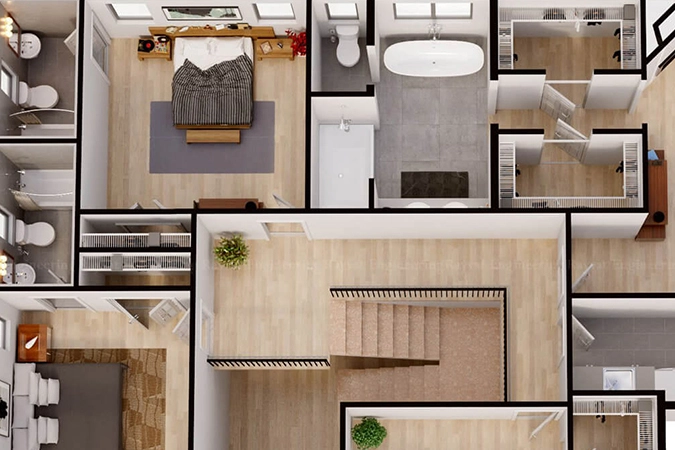Creating a functional and aesthetically pleasing floor plan is a crucial step in the architectural design process. With the evolution of technology, floor plan designers now have an array of innovative tools at their disposal to bring their visions to life. Let’s delve into the world of floor plan design and explore the tools, techniques, and considerations that define this captivating craft.

Understanding the Basics
Conceptualization:
At the heart of floor plan design lies the art of conceptualization. Designers must envision the spatial layout, traffic flow, and functionality of the intended space. This stage involves brainstorming ideas, sketching rough drafts, and exploring various design possibilities to establish a solid foundation for the project.
Spatial Analysis:
Before diving into the intricacies of design, it’s essential to conduct a thorough spatial analysis of the site or structure. Factors such as site dimensions, orientation, zoning regulations, and environmental considerations play a pivotal role in shaping the design direction. By analyzing these variables, designers can optimize space utilization and ensure compliance with local building codes and regulations.
Leveraging Advanced Tools
CAD Software:
Computer-aided design (CAD) software revolutionized the field of floor plan design by offering powerful tools for drafting, modeling, and visualization. CAD platforms enable designers to create precise and detailed floor plans, complete with measurements, annotations, and 3D renderings. These tools enhance efficiency, accuracy, and collaboration throughout the design process, empowering designers to bring their concepts to fruition with precision and clarity.
BIM Technology:
Building Information Modeling (BIM) technology takes floor plan design to the next level by integrating intelligent 3D modeling with data-rich information about building components and materials. BIM software allows designers to create comprehensive digital representations of buildings, enabling real-time collaboration, clash detection, and performance analysis. By leveraging BIM technology, designers can streamline workflows, optimize project coordination, and improve overall project outcomes.
Designing for Functionality
Space Planning:
Effective space planning is essential for maximizing the functionality and usability of a floor plan. Designers must carefully consider the needs and preferences of the end-users, as well as the intended purpose of each space within the layout. By strategically allocating space for various activities and amenities, designers can create harmonious and efficient floor plans that cater to the occupants’ lifestyle and workflow requirements.
Traffic Flow:
The flow of traffic within a space significantly impacts its usability and comfort. Designers must carefully plan the circulation paths, entry points, and spatial relationships to ensure seamless movement throughout the floor plan. Factors such as proximity to entryways, placement of furniture, and integration of circulation zones influence the overall traffic flow and user experience. By optimizing traffic flow, designers can enhance the functionality and accessibility of the space, creating a more enjoyable and efficient environment for occupants.
Embracing Creativity and Innovation
Architectural Features:
Incorporating unique architectural features can elevate the aesthetic appeal and character of a floor plan. From soaring ceilings and expansive windows to distinctive finishes and structural elements, architectural features add personality and visual interest to the design. Designers can experiment with various design elements to create focal points, establish a sense of scale, and evoke specific moods or themes within the space.
Sustainability:
In an era of increasing environmental awareness, sustainability has become a central consideration in floor plan design. Designers are incorporating eco-friendly materials, energy-efficient systems, and passive design strategies to minimize environmental impact and enhance occupant comfort. By prioritizing sustainability principles, designers can create floor plans that are not only aesthetically pleasing but also socially responsible and environmentally conscious.
Conclusion
Floor plan design is a multifaceted discipline that blends creativity, functionality, and innovation to shape the built environment. From conceptualization and spatial analysis to leveraging advanced tools and embracing creativity, floor plan designers play a pivotal role in translating architectural visions into tangible spaces. By mastering the art of floor plan design and embracing the principles of functionality, sustainability, and creativity, designers can create spaces that inspire, delight, and enrich the lives of their occupants.